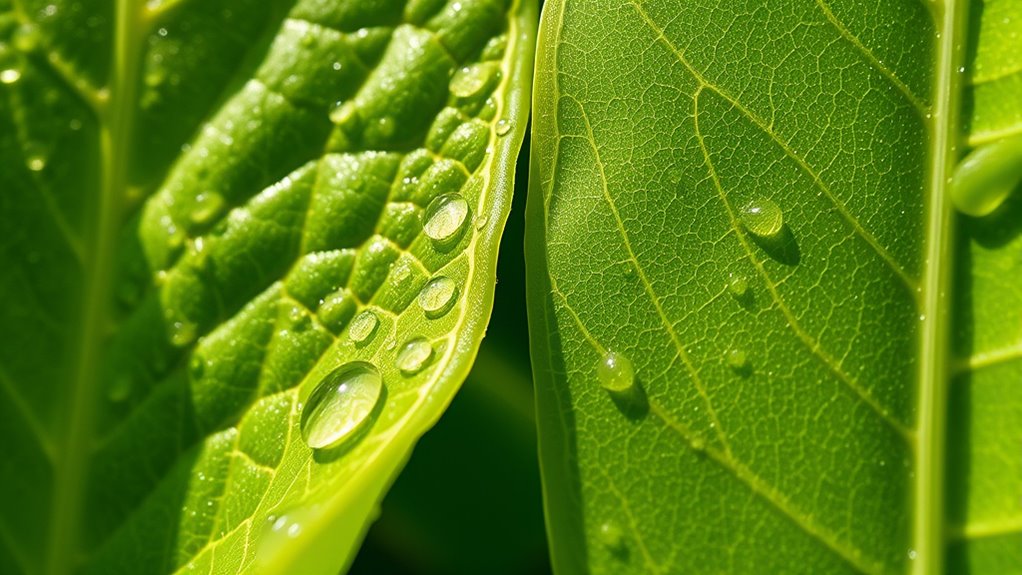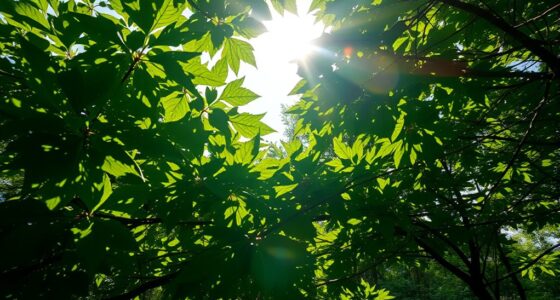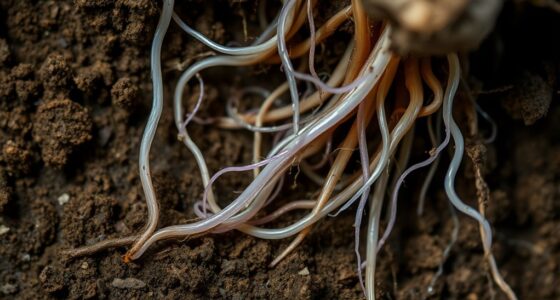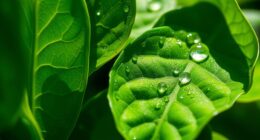C4 plants have a more efficient photosynthesis process than C3 plants, especially in hot, dry environments. They fix CO₂ into four-carbon compounds using PEP carboxylase, which minimizes photorespiration and boosts energy production. This adaptation allows plants like maize and sugarcane to grow faster and produce higher yields under stressful conditions. If you explore further, you’ll discover how these mechanisms help plants thrive and how they influence agriculture today.
Key Takeaways
- C4 plants concentrate CO₂ around Rubisco, reducing photorespiration and boosting photosynthesis efficiency under high temperatures.
- C4 pathway uses PEP carboxylase with higher CO₂ affinity, enabling faster carbon fixation in hot, dry environments.
- C4 plants are adapted to stressful conditions like drought and intense sunlight, giving them a growth advantage.
- C4 photosynthesis minimizes energy loss, resulting in higher yields in suitable climates.
- C3 plants perform well in cooler, moist areas but have less efficient photosynthesis in extreme conditions.

When comparing C4 and C3 photosynthesis, it’s important to understand that these are two different pathways plants use to convert sunlight into energy. This distinction influences their photosynthesis efficiency and reflects their unique plant adaptation strategies to various environments. C3 plants, which represent the majority of plant species, perform the initial carbon fixation directly through the enzyme Rubisco in the Calvin cycle. While effective in moderate conditions, this process becomes less efficient under high temperatures, intense sunlight, or dry conditions due to photorespiration—a wasteful process where oxygen competes with carbon dioxide, reducing the plant’s overall energy output. As a result, C3 plants often struggle with photosynthesis efficiency in hot or arid environments, limiting their growth and productivity.
In contrast, C4 plants have evolved a specialized mechanism that enhances their photosynthesis efficiency in challenging conditions. They initially fix carbon dioxide into a four-carbon compound in mesophyll cells using an enzyme called PEP carboxylase, which has a higher affinity for CO₂ than Rubisco. This compound is then transported to bundle-sheath cells, where the CO₂ is released for the Calvin cycle. This two-step process effectively concentrates CO₂ around Rubisco, substantially reducing photorespiration and boosting photosynthesis efficiency. Because of this adaptation, C4 plants excel in high-temperature, high-light, and drought-prone environments, making them more resilient and efficient in such conditions.
Your understanding of plant adaptation strategies highlights why some plants thrive in hot, dry climates, while others prefer cooler, moist environments. C4 plants, such as maize and sugarcane, have developed this turbocharged pathway to maximize energy production where C3 plants might falter. Their ability to minimize energy loss from photorespiration means they can sustain higher rates of photosynthesis, leading to faster growth and higher yields under stress conditions. Meanwhile, C3 plants dominate in cooler, wetter areas, where photorespiration isn’t as problematic, and their simpler pathway suffices for survival. Recognizing these differences helps explain why certain crops are better suited to specific climates and how plants have evolved diverse strategies to optimize sunlight capture and energy conversion. Understanding plant adaptation strategies is essential for improving crop productivity and sustainability in changing climates.
Frequently Asked Questions
How Do C4 and C3 Plants Perform Under Drought Conditions?
Under drought conditions, C4 plants outperform C3 plants because they conserve water better through efficient stomatal regulation. You’ll notice that C4 plants keep their stomata partially closed, reducing water loss while still photosynthesizing effectively. In contrast, C3 plants open their stomata wider, losing more water and struggling during drought. This adaptation helps C4 plants survive dry periods, making them more resilient in water-limited environments.
Can C3 Plants Evolve Into C4 Plants?
You might wonder if C3 plants can evolve into C4 plants. The answer is yes, through an evolutionary shift driven by genetic adaptation. Over time, environmental pressures like drought can push plants to develop more efficient photosynthesis, transforming their genetic makeup. This process isn’t a leap in the dark but a gradual change, allowing C3 plants to become C4 plants, ultimately boosting their survival in challenging conditions.
What Are the Ecological Advantages of C4 Photosynthesis?
You benefit from C4 photosynthesis because it boosts photosynthesis efficiency, especially in hot, dry environments. This strategy improves carbon fixation by minimizing photorespiration, which often hampers C3 plants. With C4’s unique carbon fixation strategies, your plant conserves water and maintains productivity under stress. As a result, C4 plants outperform C3 plants in challenging conditions, giving you a competitive advantage in arid or high-temperature habitats.
Are There Hybrid Plants With Both C3 and C4 Pathways?
Think of hybrid plants as nature’s own remix artists, blending C3 and C4 pathways to create a symphony of photosynthetic diversity. Yes, hybrid adaptation occurs, resulting in plants that harness the best of both worlds. These hybrids often thrive in variable environments, offering resilience and efficiency. By combining pathways, they become versatile performers in the plant kingdom, showcasing how evolution crafts innovative solutions for survival.
How Does Climate Change Affect C3 and C4 Plant Distributions?
Climate change impacts C3 and C4 plant distributions by altering conditions like temperature and CO2 levels, which affect photosynthesis efficiency. You’ll notice C4 plants adapt better to higher temperatures and drought, thriving in warmer, drier areas. Meanwhile, C3 plants may struggle as their photosynthesis becomes less efficient under these changing conditions. These differences lead to shifts in plant communities, with C4 plants becoming more dominant in some regions due to their superior adaptation.
Conclusion
Understanding the difference between C4 and C3 photosynthesis is like discovering two different turbocharged engines powering plants. C4 plants have a special way of capturing sunlight more efficiently in hot, dry environments, much like a sports car zooming through a tough trail. Meanwhile, C3 plants thrive in cooler, wetter areas. By knowing these differences, you can appreciate how plants adapt to their surroundings, making nature’s green machines as unique and fascinating as a well-tuned engine.










